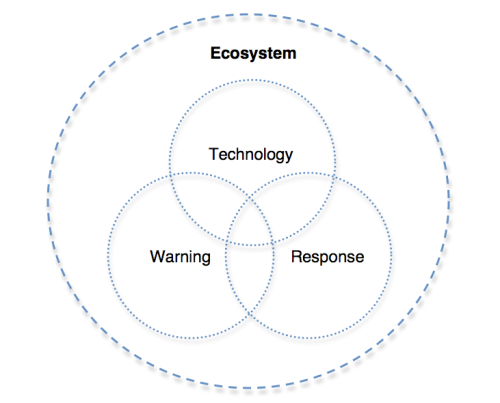I recently produced a project design for an ecosystem approach to conflict early warning and early response. The study was commissioned by a donor of ours at the Harvard Humanitarian Initiative (HHI). The donor is interested in implementing alternative approaches to conflict early warning/response and suggested an ecosystem approach based on some of our previous deliverables. We were thus asked to develop a project design to move the ecosystem concept from vision to implementation.
As a theory of change, the ecosystem concept is certainly a departure from conventional conceptual frameworks—most of which have not worked. An ecosystem approach implies a networked, top-down, bottom-up, multi-sector approach to conflict early warning/response. The core rationale behind this theory of change is that linking a range of diverse actors to foster the development of an integrated network increases the overall capacity for, and effectiveness of, operational conflict early warning/response.
Linking diverse actors requires that the right incentives, sequencing and communication technologies be in place for the “nodes” or actors of the network to link and engage in self-organized “peer-to-peer (P2P) capacity building.” P2P capacity building is defined as the transfer of knowledge and skills between two or more actors. This transfer is facilitated by communication and information sharing between two or more nodes in the network.
To this end, an ecosystem approach seeks to create the necessary incentives and communication platform(s) for actors to self-organize, create new linkages and strengthen existing linkages to improve operational response to conflict.
What are the building blocks, or DNA, of an early warning/response ecosystem? As mentioned above, an ecosystem implies a multi-sector strategy. The “nodes” or actors in the ecosystem should thus represent different sectors such as the public, social and private sectors..
Actors from each of these sectors can be grouped into three general clusters: Warning Cluster, Response Cluster and Technology Cluster. Each cluster thus represents a mix of actors from different sectors. The common element between actors within each cluster relates to their overlapping mandates. When these actors are networked, they form a cluster.
- Warning cluster: a network of actors from all four sectors engaged in information collection, monitoring, analysis, alerts and/or providing recommendations for response.
- Response cluster: a network of actors from all four sectors engaged in various forms of operational response.
- Technology cluster: a network of actors from all four sectors engaged in communications technology and related software/hardware development. Technology actors provide the communication links between all the nodes of the network.
Actors, sectors and clusters are thus the suggested building blocs the ecosystem—which can be defined as a highly connected and overlapping network of warning, response and technology clusters. The goal is to help develop and/or strengthen linkages within the ecosystem, i.e., facilitate linkages between the Technology, Warning and Response Clusters to develop the early warning/response ecosystem.
The capacity of the overall ecosystem is dependent upon the communication kinetics between actors within and between the three clusters. Indeed, strengthening and creating communication links between actors is expected to increase the capacity of individual nodes (via P2P capacity building) and the ecosystem’s overall capacity for accurate early warning and effective response.

The figure above represents the analytical framework, or DNA, for the organic evolution of a conflict early warning/response ecosystem in Liberia.

Patrick – thanks for this. I wasn’t aware that my question to you on Thursday would generate such a great response!
Thanks again for the chat, Nigel! Looking forward to many more engaging conversations.
Sir,
It is really interesting to see a new development in the EW/ER system and your initiative should be appreciated. What I felt is that the Ecosystem Approach to Conflict Early Warning/Response is seems to be a third generation Early warning system. I believe the FCE (Foundation for Co-Existence) Sri Lanka is also working using all three clusters that you have mention here. is the FCE’s system is similar to it?
Many thanks for your comment and question.
Yes, the FCE system is similar to an ecosystem approach to conflict early warning/response. At the same time, an ecosystem approach is simply an approach and not a specific single system per se. The purpose of taking an ecosystem approach, according to our partner on this project, is to “identify and influence the favorable conditions necessary to promote an environment full of various ‘species’ of early warning efforts that could grow, develop, compete, collaborate, flourish and/or whither, all with the end-goal in mind of promoting the ‘outcome’ of a ‘thick’ community of mutually interacting early warning initiatives.”
Perhaps it’s a slightly different concept?
Pingback: Fourth-Generation Early Warning Systems « Conflict Early Warning and Early Response
Pingback: Folksomaps: Gold Standard for Community Mapping « iRevolution
Pingback: Evolving a Global System of Info Webs « iRevolution